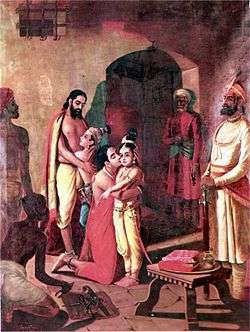Vasudeva
| Vasudeva | |
|---|---|
 | |
| Information | |
| Spouse(s) | Rohini Devi, Devaki |
| Children | Balarama, Subhadra and Krishna |
In Indian epic poetry, Vasudeva (Devanagari वसुदेव, IAST Vasudeva) is the father of Krishna. He was the brother of cowherds tribe chieftain Nanda Baba who was a Surasena[1] who was foster father of Lord Krishna.[2] His sister Kunti was married to Pandu. Kunti plays a big role later in the war Mahabharata. Vasudeva was a partial incarnation of Rishi Kashyapa. The patronymic Vāsudeva (with long ā) is a popular name of Krishna. According to the Harivansa Purana, Vasudeva and Nanda were brothers.[3]
Krishna and Bhagvatism
Vasudeva is related to Bhagavatism that was largely formed by the 1st-millennium BCE where Vāsudeva (Krishna, the son of Vasudeva) was worshiped as supreme ultimate reality (Brahman). This is evidenced by texts and archaeological evidence. As textual evidence, the Mahanarayana Upanishad records the verse:
नारायाणाय विद्महे वासुदेवाय धीमहि तन्नो विष्णुः प्रचोदयात्
We endeavor to know Narayana, we meditate on Vāsudeva and Vishnu bestows wisdom on us.
This verse asserts that Narayana, Vāsudeva (Krishna) and Vishnu are synonymous.[5] The author and the century in which the above Mahanarayana Upanishad was composed is unknown. The relative chronology of the text, based on its poetic verse and textual style, has been proposed by Parmeshwaranand to the same period of composition as Katha, Isha, Mundaka and Shvetashvatara Upanishads, but before Maitri, Prashna and Mandukya Upanishad.[6] Feuerstein places the relative composition chronology of Mahanarayana to be about that of Mundaka and Prashna Upanishads.[7] These relative chronology estimates date the text to second half of 1st millennium BCE.[6][8] Srinivasan suggests a later date for the composition of the Mahanarayana Upanishad, one after about 300 BCE and probably in the centuries around the start of the common era.[9]
Other evidence is from archeological inscriptions, where Bhagavan is documented epigraphically to be from around 100 BCE, such as in the inscriptions of the Heliodorus pillar. An Indo-Greek ambassador from Taxila named Heliodorus, of this era, worked at the court of a Shunga king, and addresses himself as a Bhagavata on this pillar, an epithet scholars consider as evidence of Vāsudeva worship was well established in 1st millennium BCE.[10]
See also
Notes
- ↑ The Cattle and the Stick: An Ethnographic Profile of the Raut of Chhattisgarh -Page 16
- ↑ https://books.google.com/books?ei=LylzU-L7IdeeugTem4HwDA&id=wT-BAAAAMAAJ&dq=abhira&focus=searchwithinvolume&q=+This+proves+that
- ↑ Lok Nath Soni, The cattle and the stick: an ethnographic profile of the Raut of Chhattisgarh. Anthropological Survey of India, Govt. of India, Ministry of Tourism and Culture, Dept. of Culture (2000).
- ↑ Hattangadi 1999, p. ॥ ७॥ Adhayaya.
- 1 2 SM Srinivaschari (1994), Vaiṣṇavism: Its Philosophy, Theology, and Religious Discipline, Motilal Banarsidass, ISBN 978-8120810983, page 132-134, 212-218
- 1 2 Parmeshwaranand 2000, pp. 458-459.
- ↑ Feuerstein 1989, pp. 119-120.
- ↑ Olivelle 1998, pp. 11-14.
- ↑ Srinivasan 1997, pp. 112, 120.
- ↑ John Irvin (1973-1975), Aśokan Pillars: A Reassessment of the Evidence, The Burlington Magazine. v. 115, pages 706-720; v. 116, pages 712-727; v. 117, pages 631-643; v. 118, pages 734-753; OCLC 83369960
References
- Feuerstein, Georg (1989). Yoga: The Technology of Ecstasy. Tarcher. ISBN 978-0874775259.
- Hattangadi, Sunder (1999). "महानारायणोपनिषत् (Mahanarayana Upanishad)" (PDF) (in Sanskrit). Retrieved 23 January 2016.
- Olivelle, Patrick (2011), Ascetics and Brahmins: Studies in Ideologies and Institutions, Anthem Press, ISBN 978-0-85728-432-7
- Olivelle, Patrick (1998), Upaniṣads, Oxford University Press, ISBN 978-0192835765
- Parmeshwaranand, S (2000). Encyclopaedic Dictionary of Upanisads. Sarup & Sons. ISBN 978-81-7625-148-8.
- Hastings, James Rodney (1908). Encyclopedia of Religion and Ethics, v.4: Behistun (continued) to Bunyan, p. 540. John A Selbie, ed. Edinburgh: Kessinger Publishing, LLC (Reprint 1990). p. 476. ISBN 0-7661-3673-6.
- Srinivasan, Doris (1997). Many Heads, Arms, and Eyes. BRILL Academic. ISBN 978-9004107588.
Further reading
- RG Bhandarkar: "Vasudeva of Panini" 4.3.98. Journal of the Royal Asiatic Society, 1910.